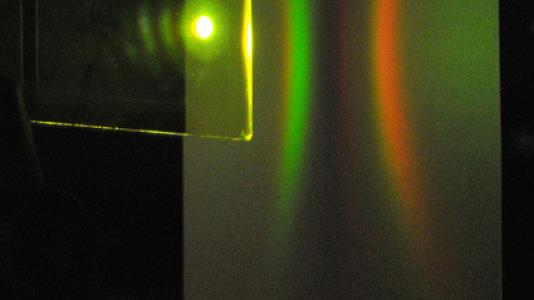
At the U.S. Department of Energy’s Argonne National Laboratory, nanoscientists Chris Giebink and Gary Wiederrecht, collaborating with Northwestern University Professor Michael Wasielewski, have investigated the use of fluorescent plastics called luminescent solar concentrators (LSCs) that can be used to lower the cost of electricity from solar cells. “In order to make solar power competitive in energy markets, we either need to get more energy from the cells we’ve already developed or find ways to make cheaper cells that give us the same amount of energy,” Giebink said.
Concentrating sunlight is one strategy to squeeze more power out of existing solar cells, which ultimately reduces the cost of the energy they produce. The question occupying researchers today is how best to gather as much sunlight as cheaply as possible. Although lenses and mirrors are one solution (think burning a piece of paper with a magnifying glass on a sunny day), they must be continually aimed at the Sun as it moves across the sky each day, which requires an expensive tracking system.
Luminescent solar concentrators are an inexpensive, alternative approach that do not require solar tracking because they capture sunlight and change it to a different wavelength, according to Giebink. “We’re actively shifting the frequency of the light by absorbing and re-emitting it,” he said. “LSCs act kind of like flat funnels—we try to absorb a lot of light over the face of a plastic slab filled with dye, and then re-direct it all back out the edges. The whole process is designed to intensify the light as much as possible.”
The theoretical potential for this intensification, Giebink said, can exceed the equivalent of one hundred “suns”—the measurement of solar radiation on one spot. However, actual implementation has until now failed to produce such high intensities. “The main problem we’re running into is that light is getting lost in the slabs either due to reabsorption or to scattering, and that’s the problem we have to solve,” he said.
Using capabilities at Argonne’s Center for Nanoscale Materials, the researchers focused on altering the way light is re-emitted and reabsorbed inside an LSC by taking advantage of optical ‘microcavity’ effects, which occur when the dimensions of a structure are similar to the wavelength of light. In this case, the scientists were able to use a series of thin films with nanometer-scale changes in thickness to produce a ‘resonance-shifting’ effect, in which light fails to “recognize” the environment that it is emitted from, drastically reducing reabsorption. “It really is like giving light amnesia—if light forgets how it came in, it’s less likely to get reabsorbed or scattered out,” Wiederrecht said.
Although the Argonne experimental research explored how LSCs work only in one dimension, both Giebink and Wiederrecht believe that a two-dimensional LSC analysis would show the even greater efficacy for resonance-shifting. “By finding better and better ways to pull this kind of switcheroo, the higher the efficiency we’re going to get,” Giebink said.
“We’ve demonstrated the general principle, now we just have to find the best pattern of dye thicknesses or alternatively the best way to vary the thickness of the glass.”
The Center for Nanoscale Materials is one of the five DOE Nanoscale Science Research Centers, premier national user facilities for interdisciplinary research at the nanoscale supported by the U.S. Department of Energy, Office of Science. Together the NSRCs comprise a suite of complementary facilities that provide researchers with state-of-the-art capabilities to fabricate, process, characterize and model nanoscale materials, and constitute the largest infrastructure investment of the National Nanotechnology Initiative. The NSRCs are located at DOE’s Argonne, Brookhaven, Lawrence Berkeley, Oak Ridge, Sandia and Los Alamos National Laboratories. For more information about the DOE NSRCs, please click here.
The Argonne-Northwestern Solar Energy Research (ANSER) Center, an Energy Frontier Research Center, is supported by the U.S. Department of Energy, Office of Science, Office of Basic Energy Sciences. The mission of the ANSER Center is to revolutionize our understanding of molecules, materials and methods necessary to create dramatically more efficient technologies for solar fuels and electricity production.